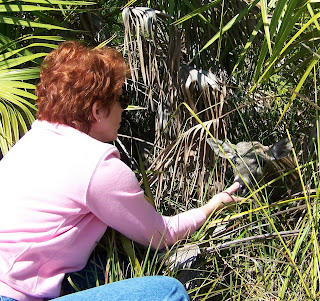Book Lovers Inc.
Romance Novel Reviews, Author Interviews, Commentary
All YA Love: Interview with Bonnie Doerr
 It is our pleasure to have had an opportunity to talk with Bonnie Doerr, author of Island Sting.
It is our pleasure to have had an opportunity to talk with Bonnie Doerr, author of Island Sting.
Tell us a bit about ISLAND STING.
Telling about a novel I wrote should be an easy thing for me to do, right? But the book has been described so many ways by readers that I often don’t know how to approach this request. And, honestly, it’s more about what the book is to readers than what it is to me. So first I’ll use the thoughts and words of others to talk about it.
To ground the story, ISLAND STING is a contemporary adventure/mystery novel set in the Florida Keys. Though it’s often included on lists of YA reads (these days YA seems to stretch up to college age), it’s more for younger teens and tweens.
I get a kick out of stringing together reviewers’ comments to describe the overt story. It goes something like this: reading ISLAND STING is like jumping into the world of a green and gritty Nancy Drew who has teamed with a rugged, savvy Hardy boy. With combined goals of cracking the endangered-species-killer case and curbing pollution, the two inspire a wild-west style green-teen vigilante group. The impassioned teens secretly patrol their island, not on horseback, but on bicycles packing an arsenal of cameras.
There’s an underlying layer to the story though—a magnetic push/pull dynamic between Kenzie and Angelo. In part, this interaction results from their shared experience with loss and their differing cultures.
The main character, Kenzie, is a brave, determined (stubborn?) girl with a big heart and a love for the environment. You also have a share this passion, was her character based on yourself OR anyone you know?
Yup, she’s all those things and more, like dangerously impetuous. Her poor mother…
I’m determined. That part is me. When I commit to something I won’t quit until it’s over (as evidenced by the road to Island Sting’s publication). The finish doesn’t always bring success, but I follow the path until I see the sign that spells THE END. I’m also very much an outdoor gal. But, unlike me, Kenzie didn’t develop that love until Angelo introduced her to his world.
 I’ve always loved being outdoors. It’s where I feel closest to God. I have to spend time outside surrounded by trees, plants, and critters every day or I go nuts. This was my dad’s doing. He was a serious Boy Scout leader. And lead he did. He took our little family all over the country, camping, hiking, and generally exploring the great outdoors. It’s tragic how disconnected from nature many people are today. No wonder our culture has lost understanding and respect for the environment. People forget how our very lives depend on the natural world.
I’ve always loved being outdoors. It’s where I feel closest to God. I have to spend time outside surrounded by trees, plants, and critters every day or I go nuts. This was my dad’s doing. He was a serious Boy Scout leader. And lead he did. He took our little family all over the country, camping, hiking, and generally exploring the great outdoors. It’s tragic how disconnected from nature many people are today. No wonder our culture has lost understanding and respect for the environment. People forget how our very lives depend on the natural world.
Lately though, I’ve come to understand that the big, bold, brave part of Kenzie was based on a neighbor’s child I adored when I was still living in the Florida Keys. That little girl is now 21 and a sailor in the Coast Guard, and I still love her. A few weeks ago I saw her for the first time in years. She’s truly my Kenzie. Bold, brave and out there saving lives while putting her own on the line. I experience chills, tears, and a warm squeeze in my chest just thinking about Hali.
There were quite a few important messages brought up in ISLAND STING. What do you hope readers take away from the book?
You know, I never intended to convey any one specific message, but it’s interesting to hear what messages readers are finding as well as to see how ISLAND STING is being marketed. And I’m okay with reading messages into the story if people also enjoy ISLAND STING as a fun read. After all, each reader experiences something unique while conversing with a book. I did want to sneak in some environmental science much as history is woven into a historical novel. That’s one reason I included author notes in the back of the book. And once I saw the direction promotion and marketing was going, I ran with it. But to be honest, I simply hoped to give readers a true outdoor experience set in what for many is an exotic locale. I also think of ISLAND STING as my love letter to the Florida Keys, a fragile environment about which I care deeply. But you know, our entire planet’s environment is troubled, isn’t it?
Okay, now I’ll force myself to simplify what I hope readers to take away. Hey, that’s it— hope! Hope for our planet. ISLAND STING conveys an uplifting message: if we suffer loss, be it personal, or environmental, we can change the effects of that loss. We can change the future. The story makes us realize that though humans nearly wiped out an entire species, humans also saved that species, and it reminds teens that they have power. They can act not only to improve their own lives but to solve wider problems adults have left unresolved. Teen power! Yes!
Did you have a chance to visit the refuge and see Key Deer as part of you research?
Absolutely. I spent hours observing Key deer behavior and watching humans interact with them. Usually the encounters were friendly, but many times residents were shooing off the greedy little things like flies from a picnic table. But the first time a visitor sees a Key deer the awww factor reigns supreme. In addition, I spent time with wildlife officers who showed me behind the scenes facilities, filled me in on procedures, and shared many true accounts with me. I also communicated with one of the Texas A&M researchers who generously “vetted” my manuscript before I sent it out. I think all this research was my favorite part of the process. And I spent a great deal of time in the Keys back country fishing, lobstering, boating, and sightseeing. So I had a vivid sense of Angelo’s experiences and why he is so passionate about his island home.
In your authors notes, you mention 11 year old Gary Allen. Was the idea for ISLAND STING born from his story? (What came 1st ,the chicken or the egg?)
I’m certain when I uncovered the story of Gary’s concern for the dwindling population of the Key deer species it influenced ISLAND STING. Any time a child cares enough about a topic to contact not one, but two presidents, and sees results (in this case in the formation of a national wildlife refuge) that’s inspiration! But much of the idea came from actual news stories about the daily dangers these charming creatures face. I remember reading about severed deer heads being tossed in strategic locations and mortality statistics due to deer gobbling garbage as they foraged. Events like those found their way into the manuscript.
Is ISLAND STING your first novel & how long did it take to write?
ISLAND STING is my first nationally released novel. The idea actually began with a short story that was published in a Milkweed Editions literary field guide. I couldn’t get the characters of Kenzie and Angelo out of my mind. I knew they wouldn’t suddenly meet, share this amazing experience of rescuing an endangered animal, and then say, “Good job. Bye. Have a nice life.” They were bound to share an intense future, and I wanted to find out that future entailed.
If one considers the journey from seed to publication, with years of neglect in between, as well as acceptance by two publishers that folded before Leap Books offered the contract, I’d have to say it took ten years. Yikes. ISLAND STING truly is a miracle, isn’t it?
But I wasn’t actually writing all that time. The How long did it take to write? question is interpreted differently by authors. To me writing includes thinking, researching, jotting notes, photographing, dreaming, and scads of other processes all before tapping computer keys.
Chapter 1 of the next book, STAKEOUT is included at the end. Can you tell us a bit about this story?
As much as I enjoyed writing ISLAND STING, I had more fun with STAKEOUT. It’s more whimsical than the first book and includes several new quirky characters. Angelo and Kenzie are back, of course, along with Kenzie’s mischievous new puppy, Salty, who becomes known as the turtle dog. Fisher and Mike are there also, along with the KTC (Keys Teens Care) gang. But a new KTC member, Ana, insisted on joining their mission. I only recently figured out when Ana began to inch her way into my subconscious. It happened a couple years ago at Bahia Honda State Park. There I saw a beach wheelchair for the first time. That had to be the moment the cheery, reliable, resilient Ana was conceived.
STAKEOUT takes place shortly after the Key deer poacher is caught. Kenzie hears a news flash about the destruction of sea turtle nests and finally realizes what she can do to help Old Turtle, a NYC aquarium sea turtle, with whom she once had a surreal encounter. She commandeers Angelo’s boat to head for Turtle Beach, and the next KTC challenge begins, complete with a wacky chicken catcher, a mysterious cranky old woman, exotic potions, turtle watchers, and lots of details about the very real Marathon Turtle Hospital.
Will there be more to this series?
I sure hope so. I’m thinking pelican problems next. I began some research on that issue this past February. We’ll have to see what the publishing world thinks.
I enjoyed being with you, Mel. I learned more about ISLAND STING myself as I thought about each question. It’s kind of like therapy. Thanks for the experience!
Thanks so much Bonnie. I loved Island Sting and can’t wait for Stakeout…and hopefully more!
(pssst, did you guys notice the key deer in the last picture above? How cute are they!)
About the book:
Kenzie Ryan’s New York know-how and private girls’ academy education prove useless in the middle of an island wildlife refuge.
Upon arrival in the exotic Florida Keys, she is thrown into the midst of an ecological mystery involving the endangered Florida Key deer. How can she navigate this upside down world? A world deftly maneuvered by Angelo–island native and nerve-wracking hunk. The two team up to accomplish what perplexes law enforcement, but Angelo exposes Kenzie’s insecurities, as well as her inexperience with nature and the opposite sex.
Danger and disagreement follow the pair wherever they go. Enamored with Angelo and his local savvy, Kenzie hopes to secure his loyal friendship. But how can she win Angelo’s trust when what she must tell him will crush his ego?
Island Sting includes notes on the endangered Florida Key Deer and the National Key Deer Refuge.
About the author:
Bonnie J. Doerr has always played with words, ideas, and nature. To be separated from nature—to be containerized—would slowly suck the breath from her. For years this therapeutic pursuit manifested itself in poetry. In recent years her play resulted in stories and novels for young adults. A lifetime educator, she has taught students from kindergarten to college in eight states. Degrees in reading education, combined with a brief post as a science teacher, led her to write ecological mysteries. Years of teaching and living in the Florida Keys provided irresistible material. Her novels celebrate caring, involved, “green” teens who take action with attitude and a touch of romance. Her work has been honored by NOAA (National Oceanic and Atmospheric Administration) with a grant for its use in environmental education and has been included in Milkweed Editions literary field guides. When not nurturing her muse in the Florida Keys, she lives in a log cabin in North Carolina.
Share This Post
Subscribe and stay up-to-date
0 Comments
« Review: Before I Fall by Lauren Oliver Next Post
Review: Montana Rose by Mary Connealy »

















 Blog RSS Feed
Blog RSS Feed Follow Me on Twitter
Follow Me on Twitter My Facebook
My Facebook